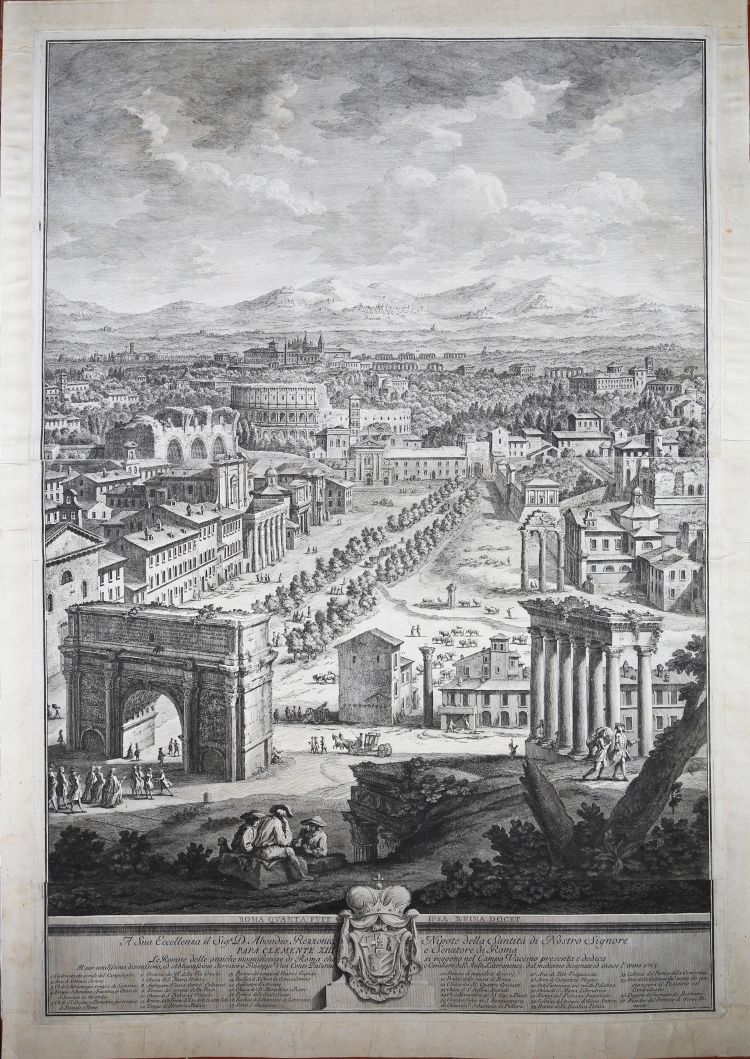



| Reference: | S42514 |
| Author | Giuseppe VASI |
| Year: | 1765 |
| Zone: | The Roman Forum |
| Printed: | Rome |
| Measures: | 1015 x 688 mm |


| Reference: | S42514 |
| Author | Giuseppe VASI |
| Year: | 1765 |
| Zone: | The Roman Forum |
| Printed: | Rome |
| Measures: | 1015 x 688 mm |
A Sua Eccellenza il Sig.r D. Abondio Rezzonico Nipote della Santità di Nostro Signore/ Papa Clemente XIII e Senatore di Roma/ Le rovine delle antiche magnificenze di Roma che si veggono nel Campo Vaccino presente e dedica/Il suo umilissimo, divotissimo, ed obbligatissimo Servitore Giuseppe Vasi Conte Palatino e Cavaliere dell'Aula Lateranense, dal medesimo disegnate ed incise l'anno 1765
Three-sheet etching [101.5 x 68.8 cm the platemark].
First edition, printed on contemporary laid paper, with margins, good condition.
Rare, large-format, separately issued etching on three-sheets by Giuseppe Vasi (1710-82) depicting the Roman Forum. The work is one of four large vedute etchings – two published in 1765 and two in 1771 – incorporating the four patriarchal basilicas of Rome into sweeping vistas seen from some of the city’s most celebrated vantage points. Vasi seems to have designed these etchings to be displayed either on their own or in conjunction with his iconic 18-sheet Prospetto dell’Alma città di Roma (1765), a breathtaking panorama of the city unsurpassed in its ambition: “Vasi’s large prints of the four patriarchal basilicas were issued with exactly the same vertical dimensions as the Prospetto in order to grant uniformity to and enhance the aesthetics of collective display. In Vasi’s scheme, then, any single work could stand alone, or be enriched through association with related material” (Maier, p. 219), a feature typical to European décor in the second half of the 18th century (and which provided Vasi with commercial flexibility in marketing his prints).
This view of the Forum, then called the Campo Vaccino, is taken from the Campidoglio looking past the partly submerged arch of Septimius Severus down the ancient via Sacra to the Colosseum. Vasi dedicated the print to Abbondio Rezzonico, the nephew of Pope Clement XIII who had just been awarded the title of senator
“A native of Corleone, Sicily, Vasi had arrived in Rome in 1736, where he became known for his vedute catering to Grand Tourists’ insatiable desire for souvenirs of the Eternal City. Like Falda in the previous century, Vasi specialized in relatively unembellished interpretations of Rome’s settings and architecture that situated monuments in their urban context. In this regard he distinguished himself from his competitor Giovanni Battista Piranesi, whose vedute offered a more romantic vision of Rome’s monuments, and often isolated them for dramatic effect” (Maier, p. 218). Vasi’s reputation today rests on his role as the engraver for Nolli’s influential pianta grande, on his Prospetto, and on his 10-book Magnificenze di Roma antica e moderna (1747-61), a commemorative set of Roman architectural views arranged by building type.
Bibliografia
L. Scalabroni, Giuseppe Vasi (1710-82), pp. 92-3; J. Maier, Rome Measured and Imagined: Early Modern Maps of the Eternal City; C.A. Petrucci, Catalogo generale delle stampe tratte dai rami incisi posseduti dalla calcografia nazionale, 1218, p. 125.
Giuseppe VASI (Corleone, 27 Agosto 1710 - Roma, 16 Aprile 1782)
|
Italian engraver and painter. After completing a classical education, he trained as a printmaker in Palermo, possibly at the Collegio Carolino, which was founded by the Jesuit Order in 1728 and at which the etcher Francesco Ciché ( fl before 1707; d Palermo, 1742) was a teacher. Vasi was already an accomplished engraver when, in 1736, he contributed to the illustration of La reggia in trionfo by Pietro La Placa, which described the festivities held in Palermo to mark the coronation of Charles VII of Naples (the future Charles III of Spain). That same year Vasi moved to Rome, where, as a Neapolitan subject, he was immediately afforded the protection of the ambassador, Cardinal Troiano Aquaviva d’Aragona (1694–1747). In Rome he met other artists who worked for the same patron: Sebastiano Conca, Luigi Vanvitelli and Ferdinando Fuga. It is against this background that Vasi’s work in Rome, when he was in residence at the Palazzo Farnese, should be considered: his monopoly as the engraver of the Roman records of the monarch, the plates for the festivals of the ‘Chinea’ and the triumphal arches erected in front of the Palatine gardens on the occasion of temporal sovereignty over Rome
|
Giuseppe VASI (Corleone, 27 Agosto 1710 - Roma, 16 Aprile 1782)
|
Italian engraver and painter. After completing a classical education, he trained as a printmaker in Palermo, possibly at the Collegio Carolino, which was founded by the Jesuit Order in 1728 and at which the etcher Francesco Ciché ( fl before 1707; d Palermo, 1742) was a teacher. Vasi was already an accomplished engraver when, in 1736, he contributed to the illustration of La reggia in trionfo by Pietro La Placa, which described the festivities held in Palermo to mark the coronation of Charles VII of Naples (the future Charles III of Spain). That same year Vasi moved to Rome, where, as a Neapolitan subject, he was immediately afforded the protection of the ambassador, Cardinal Troiano Aquaviva d’Aragona (1694–1747). In Rome he met other artists who worked for the same patron: Sebastiano Conca, Luigi Vanvitelli and Ferdinando Fuga. It is against this background that Vasi’s work in Rome, when he was in residence at the Palazzo Farnese, should be considered: his monopoly as the engraver of the Roman records of the monarch, the plates for the festivals of the ‘Chinea’ and the triumphal arches erected in front of the Palatine gardens on the occasion of temporal sovereignty over Rome
|